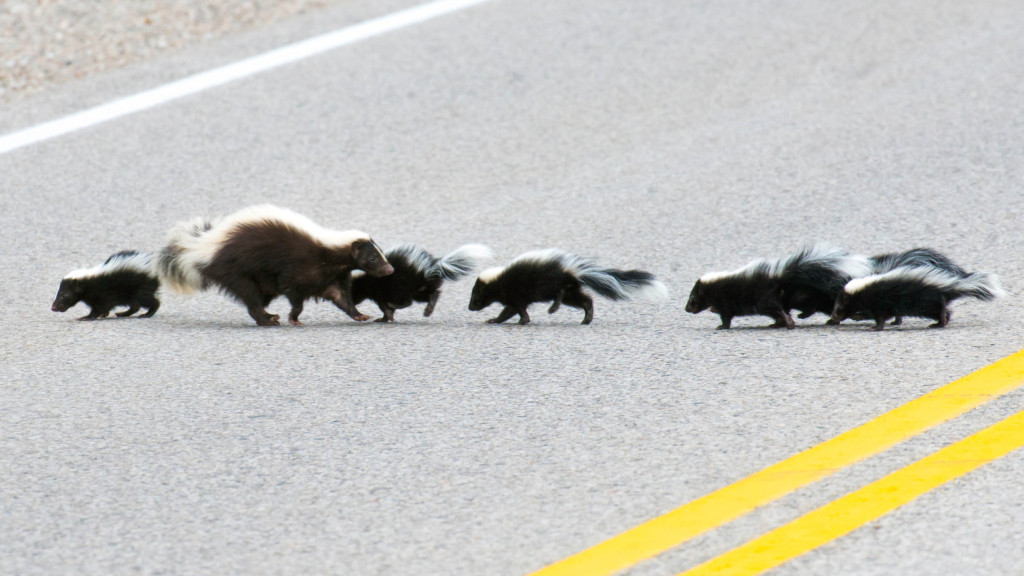With the weather warming up, stay alert on the roads! This week’s blogpost is written by Hannah, a Bucktails and Drummers alumna. Hannah gives some insight on recent research conducted on roadkill and how to decrease the amount of road kill. Read on to learn more!
When driving, it is easy to notice the carcasses of various animals on the sides of the road. Researchers from the University of Oklahoma decided to do some studies on wildlife accident victims. For every hundred miles driven, fourteen vehicle accidents involving wildlife were found in one study. In another study, the southern Great Plains of Kansas, Oklahoma, and Texas were observed. The researchers came across 1,412 roadkill victims in 10,250 miles, over a three year period. This data did not include unidentifiable carcasses or animals that ran off before they died.

During these studies, 18 species of dead mammals were identified along the roads in woodlands, prairies, and rural country side. Eighty five percent of all the roadkill involved four main species: striped skunk, Virginia opossum, nine-banded armadillo and northern raccoon. Some species depend on their innate survival strategies, which do not necessarily work against vehicles. For example, skunks “freeze in place” and do not try to get out of the way of moving vehicles, while armadillos vertically jump when startled instead of immediately running. A high number of white-tailed deer and squirrels are also killed due to collisions. It is noted that accidents frequently happen in a “repeated” place, often highly traveled crossing areas.

Most accidents take place on two-lane roads or on roads travelled at a faster rate. Roads that are gravel or travelled at a slower rate have a lower number of wildlife collisions. Highways with multiple lanes often seem to deter animals from crossing, decreasing the kill rate. For example four-lane highways have fewer accidents because the animals seem to sense the danger of crossing. During certain times of the year, usually spring, roadkill becomes more frequent because animals begin to move around looking for mates, or the young depart from their parents.

Wildlife accidents could be avoided by creating more underpasses. Research should be completed to find more solutions. One quotes “A society that tolerates such a large number of road kills places too little value on wildlife.”

Roads Take a Toll on Wildlife
Posted: May 9, 2016 by Academy Director
With the weather warming up, stay alert on the roads! This week’s blogpost is written by Hannah, a Bucktails and Drummers alumna. Hannah gives some insight on recent research conducted on roadkill and how to decrease the amount of road kill. Read on to learn more!
When driving, it is easy to notice the carcasses of various animals on the sides of the road. Researchers from the University of Oklahoma decided to do some studies on wildlife accident victims. For every hundred miles driven, fourteen vehicle accidents involving wildlife were found in one study. In another study, the southern Great Plains of Kansas, Oklahoma, and Texas were observed. The researchers came across 1,412 roadkill victims in 10,250 miles, over a three year period. This data did not include unidentifiable carcasses or animals that ran off before they died.
During these studies, 18 species of dead mammals were identified along the roads in woodlands, prairies, and rural country side. Eighty five percent of all the roadkill involved four main species: striped skunk, Virginia opossum, nine-banded armadillo and northern raccoon. Some species depend on their innate survival strategies, which do not necessarily work against vehicles. For example, skunks “freeze in place” and do not try to get out of the way of moving vehicles, while armadillos vertically jump when startled instead of immediately running. A high number of white-tailed deer and squirrels are also killed due to collisions. It is noted that accidents frequently happen in a “repeated” place, often highly traveled crossing areas.
Most accidents take place on two-lane roads or on roads travelled at a faster rate. Roads that are gravel or travelled at a slower rate have a lower number of wildlife collisions. Highways with multiple lanes often seem to deter animals from crossing, decreasing the kill rate. For example four-lane highways have fewer accidents because the animals seem to sense the danger of crossing. During certain times of the year, usually spring, roadkill becomes more frequent because animals begin to move around looking for mates, or the young depart from their parents.
Wildlife accidents could be avoided by creating more underpasses. Research should be completed to find more solutions. One quotes “A society that tolerates such a large number of road kills places too little value on wildlife.”
Category: Youth Blog Tags: Bucktails, drummers, nature observation, wildlife, youth